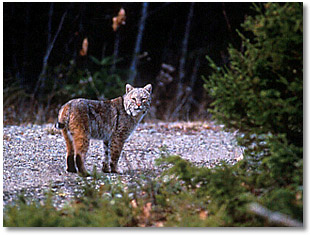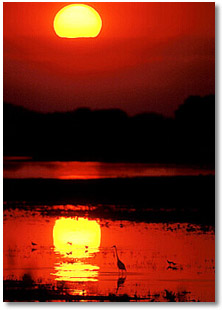|
The Camera Hunter®
Photography and Text Copyright Bill Silliker, Jr.
All rights reserved.
Take Care With Where You Point Your Camera
 I wanted this picture very much! I'd never even seen a bobcat in the wild. But the big center weighted meter on the Nikon F3 said NO when I aimed a 400mm telephoto lens through the dusty windshield, and that was with a 1/60 second shutter speed. At the time, you couldn't hope to get a clear shot hand-holding a heavy lens at that slow a shutter speed and my tripod lay folded up on the back seat.
I wanted this picture very much! I'd never even seen a bobcat in the wild. But the big center weighted meter on the Nikon F3 said NO when I aimed a 400mm telephoto lens through the dusty windshield, and that was with a 1/60 second shutter speed. At the time, you couldn't hope to get a clear shot hand-holding a heavy lens at that slow a shutter speed and my tripod lay folded up on the back seat.
Today, that has changed. With the introduction of image stabilization (IS) lenses by Canon and the new vibration reduction (VR) 80-400 zoom lens by Nikon, this shot would have been a no-brainer. (See Outdoor Photographer, April 2001 issue, for a review of the Nikon VR lens.) But when this rare photo opportunity presented itself on that May evening 8 years ago, I was stuck with the technology that many of us still use today.
Whatever your equipment capability, consistent success at camera hunting requires a total familiarity with it. Simply knowing how to use your camera - which buttons to push, what the meter says - is a good place to start. But that's not enough to meet the challenges of photographing most wildlife. You must train yourself to use your equipment as a reflex action.
The first step? Find and read your camera manual. Then practice. Read photography books and magazines, including the many postings and articles on this web magazine. And practice some more. Maybe take a photography course or workshop. And practice some more. Then read your camera manual again. You'll be surprised at how much they've added to it.
To really know exactly what your equipment can and cannot do, shoot lots of film. Hey, it's fun. Besides, your photo processor will love you. Then edit ruthlessly. Only don't just keep the winners, but instead study all of your results. Learn what doesn't work too, and figure out what you did wrong before you toss the rejects.
It helps if you use the same film all of the time, at least until you learn what that film can and cannot do. Since film choice is just that - your choice depending on your purpose - let's just say that I was shooting 100 ASA speed Fujichrome professional slide film when this big kitty came along.
And now, back to that story. But first trust that the process described below took far less time than it's will take for you to read about it. And that's the whole point of this month's column: if you have to stop to figure it out, you'll often miss the shot.
 How long do you think the bobcat stared at me as the sun set at the Baring Division of the Moosehorn National Wildlife Refuge? (Delorme's The Maine Atlas and Gazetteer Map 36, C-5). I never checked my watch. But I can tell you that, as it so often does, the whole day's camera hunting came down to a matter of mere seconds. How many bobcats have you had a look at in the wild? Did they hang around to pose for you?
How long do you think the bobcat stared at me as the sun set at the Baring Division of the Moosehorn National Wildlife Refuge? (Delorme's The Maine Atlas and Gazetteer Map 36, C-5). I never checked my watch. But I can tell you that, as it so often does, the whole day's camera hunting came down to a matter of mere seconds. How many bobcats have you had a look at in the wild? Did they hang around to pose for you?
The first thing that I had to do was to figure out how to hold the camera as steady as possible. The answer: open the cars door a bit to get the angle for the shot and rest the camera on the open window. Shooting through the windshield was definitely out: the curvature of windshield glass makes for too poor an optical quality. While you can "shoot through" many things that are within the minimum focusing distance of a telephoto lens - a blade of grass or even a twig that is so close to the lens that it doesn't show - curved glass distorts an image badly. And dirty curved glass is even worse.
I eased the car door open as quickly and as smoothly as possible without any abrupt motions. The bobcat just stared at me. As I slid out behind the door and crouched, I cranked the shutter speed up to 1/125 second and rested the barrel of that heavy Nikkor 400mm f3.5 telephoto lens on the open window of the car door…and the camera's meter still said NO. But a slower speed would surely have wasted this rare opportunity. It was pushing the envelope to hold nearly 10 pounds of camera and lens steady while leaning it on a wobbly car door at that shutter speed. I didn't even consider setting up the tripod. That bobcat would never have stayed around for that. I ignored the meter and composed and focused. I squeezed the shutter release gently. The bobcat ran at the first click. My second shot shows just its east end headed west. But you only need one.
So how did I get this image if the camera meter said NO? The meter in my camera - and in yours too - is calibrated to guide exposures for "average" scenes, based on their reflectance of light, or what is called 18 percent gray. Thinking of 18 percent gray as reflecting an amount of light halfway between the amounts of light reflected by an all white object and the amount of light reflected by an all black object is a good way to visualize the concept. The area I metered for this shot had a lot of typical Maine woods in it, and typical Maine woods in not an average scene. Because I've spent some time metering those trees, I knew that they reflect from one to two f stops less light than an average scene.
I also knew that an f-stop equals a shutter speed in its impact on exposure. And so I guessed that I had enough light to properly expose an "average" bobcat at 1/125 second because the darker background was fooling the meter. Just to be sure I ran to the spot after the bobcat left and metered off of the gray card that I always carry for a guide. And the camera's meter said YES!
But what if my after-the-fact metering had said that there wasn't enough light? I was prepared to have my film "pushed" - specially processed - to match the exposure setting used. But that's a subject for another column.
Catch yours in the good light.
BS-NPN
Maine wildlife & nature photographer Bill Silliker, Jr. – The Mooseman - photographed at many wild places in North America, with the results published in magazines internationally and in 9 of his own books. Bill was an instructor of wildlife and nature photography for L. L. Bean's Outdoor Discovery Program and a member of the Fuji Film Talent Team. Read more about Bill on the Camera Hunter archives page.


| 


